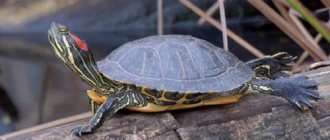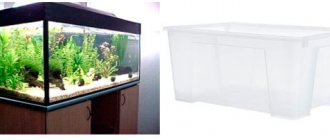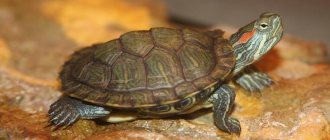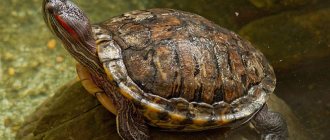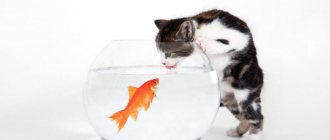Eating at home
The diet of pets should include multivitamins and minerals that are essential for their full life. Immediately after purchase, it is advisable to feed the turtle the same food that the seller previously fed it, gradually introducing new components. The optimal feeding time is during the day, when the pet is most active. Before feeding, the animal must warm up enough for it to develop an appetite. Therefore, it is best to feed your pet 1.5-2 hours after turning on the heating device. When turtles feel hungry, they begin to move restlessly around the terrarium or along the bottom of the reservoir. To understand what food is right for your pet, you need to determine its type. Turtles are divided into 3 main subgroups, depending on the type of food:
- Predatory. They often eat meat; only 10% of their menu consists of plant-based foods. This subgroup includes almost all aquatic species - trionics, red-eared - young animals, swamp - young animals. Their menu is based on seafood and lean fish.
- Herbivores. They eat plants, vegetables, fruits, only occasionally trying meat products. This includes land species - Central Asian breed, Mediterranean.
- Omnivores. Meat and vegetable crops are consumed in approximately equal proportions. The last subgroup includes land turtles of certain breeds, red-eared, marsh, and red-footed turtles.
What foods can be given to turtles and in what form?
Rubies eat almost all types of meat without cooking, fish and seafood. So, from meat, you can give your armored pet a piece of beef heart (raw), a little raw minced beef or chicken. But the turtle does not need fatty pork, lard, duck or lamb.
If the meat has been frozen, then it should be placed in the aquaterrarium after defrosting, that is, when it reaches room temperature. But boiled fish, on the contrary, should be cooled and not served hot.
Fish should also be present in the diet. It must be boiled - not for the sake of the turtle's culinary preferences, but for the sake of its safety, because raw fish contains parasites! In raw or boiled form, you can also give the meat of squid, mussels, rapana, shrimp - all seafood is useful for the red-eared turtle.
From non-meat, you can sometimes feed with pieces of raw carrots, apples, hard pears, cabbage or lettuce leaves - plant nutrition is also important (though not everyone willingly eats it)
Principles of feeding aquatic turtles
Main set of products:
- River and sea low-fat fish (pollock, hake, cod, navaga, perch);
- Liver (beef, chicken, fish) - about once a week.
For adult animals, large fish need to be cut into pieces, the backbone crushed, crushed, small fish can be fed whole. For young fish, the fish should be cut into small pieces along with the bones, after removing the ribs. Addition to the main menu:
- Various raw seafood (shell shrimp, squid, octopus - tentacles only, mussels, oysters);
- Meat (crabs, frogs, fodder hairless mice, baby rats);
- Snails (helix aspera terrestrial, large pond snails, apple snails, coils) - feed small ones whole, large ones - without shell;
- Some insects, other living microorganisms (bugs, food cockroaches, earthworms and mealworms, hairless caterpillars, daphnia, fillies, bloodworms, gammarus, tubifex, woodlice);
- Some plant components (aquatic plants, fruits, vegetables, some types of cabbage);
- Special industrial food for certain types of freshwater turtles (loose, granular, in the form of tablets, sticks, flakes, capsules).
Components of plant origin should not prevail over meat foods. For aquatic reptiles, plants are only one of the sources of vitamins and beneficial microelements. During cold seasons, it is recommended to introduce specialized vitamin complexes for aquatic and sea turtles.
Diet of the red-eared slider
The diet of red-eared turtles is compiled taking into account the fact that this type of reptile belongs to predators, therefore the main element in their menu is animal food, and plant food is used as a supplement in the amount of 25-30% of the total food. When developing a diet, the age of the pet is also taken into account; for the diet of reptiles under one year old, use those products that contain more protein. The nutritious diet is divided into winter and summer, while fresh vegetables can be replaced with frozen foods or dry food.
Feeding land turtles
Main set of products:
- Fresh greens - plants that are not toxic to turtles (lettuce, cabbage, dandelion leaves, various flowers, grass) - approximately 80% of the menu;
- Vegetables (zucchini, cucumbers, carrots, tomatoes) - about 15% of the menu;
- Fruits (bananas, apples, pears) – the remaining 5%.
Addition to the main menu:
- Champignons and other easily digestible mushrooms;
- Vegetable crops (a small amount of sorrel, plantain, coltsfoot, lawn grass, thistle - leaves, clover, peas, timothy, sprouted oats, speedwell);
- Fruits (citrus fruits - orange, tangerine, mango, plum, apricot, peach, melon);
- Vegetables (bell peppers, beets, onions, carrot tops, squash, pumpkin, artichoke, horseradish - a small amount, legumes)
- Berries (watermelon, strawberries, wild strawberries, raspberries, edible wild berries);
- Bran, sunflower seeds (not fried), dry yeast, dry seaweed;
- Special dry food for land breeds (Wardley, Tetra, Sera);
- Hard-boiled chicken egg – once a week;
- Snails, slugs, insects - once a month.
Periodically add calcium supplements to your pet's menu, and during the cold season, special multivitamins. Never overfeed your pets, but also do not limit the list of products to 1-2 components. The food must be balanced and must include all the necessary vitamins, otherwise there is a high risk of dangerous diseases, growth disorders, development, obesity or exhaustion, and death of the animal. Many breeders have a question: should a turtle be given water? Land turtles are not adapted to take in water. Usually, when you try to give reptiles water, liquid flows out of their mouths. If dry food predominates in your pet's diet, animals may experience thirst more often than their relatives, who eat mainly vegetables and fruits. To prevent dehydration, experienced owners advise using two methods:
- It is necessary to include succulent plant foods in your pet’s menu as often as possible.
- Another way to give an animal water to drink is to bathe it. The optimal bathing time for land turtles is 30-50 minutes. The water should not reach the level of the nostrils. With proper bathing, the reptile's body is sufficiently saturated with moisture.
It should be borne in mind that in markets, as well as in pet stores, turtles usually experience dehydration, so after purchasing, the first thing it is recommended to do is give your new pet a bath so that it receives the required amount of water.
How do aquatic turtles get along with each other?
When keeping aquarium turtles, the question sometimes arises: how to add a baby to an adult, or how to make friends with representatives of different species. Large and small red-eared turtles can be friends together if their sizes do not differ much and the younger individual has reached a length of at least 4-5 cm. In this case, you also need to carefully monitor feeding - a large turtle should not starve, so as not to consider the small one as prey. It is better to use separate containers for feeding reptiles to avoid fights for food.
At home, it is difficult to find enough space to equip different habitats for several reptiles, so turtles of different species often coexist in one aquarium. It is not recommended to do this, because reptiles can fight, but still, red-eared turtles are sometimes kept together with marsh or Caspian turtles, which are characterized by fairly non-aggressive behavior. Before adding a new pet to the others, it must undergo quarantine so as not to infect the common aquarium with dangerous bacteria or fungi.
Other interesting articles
- What fish can live without aeration, air in the aquarium? What fish can survive without oxygen and filtration? No living creature can live without...
- Can a red-eared turtle lay eggs in an aquarium? The simultaneous keeping of different-sex individuals of red-eared turtles at home, provided that optimal conditions are created, can...
- Astronotus with whom can live in the same aquarium Astronotus is a bright and predatory representative of the cichlid family, whose appetite and food preferences often lead...
Feeding omnivorous turtles
The main menu of omnivorous reptiles includes food of plant and animal origin in equal proportions. It is important to select a menu depending on the subspecies of reptile. For example, animal food consisting of terrestrial inhabitants (feeding mice, baby rats, frogs, insects, snails, slugs) is suitable for land animals, and fish and seafood are suitable for aquatic animals. The situation is the same with foods of plant origin. Land breeds should eat terrestrial plants, vegetables, and some fruits, while aquatic breeds are more suitable for algae and other aquatic plants.
Distinctive feeding features of small and adult individuals
There are some differences in feeding between small and adult reptiles. Young turtles grow very quickly, so you need to feed them daily, while adults need to eat 2-3 times a week, eating all the food to the end. The diet of young animals should be as varied as possible, be sure to include vitamin D, which prevents the development of rickets, calcium, necessary for proper shell growth, multivitamins, and minerals. There are situations when a pet is forced to go without food and moisture for some time. Here, too, there are distinctive features regarding the age of the individual. Adults can go without food for up to two weeks without experiencing any discomfort. Young turtles, including three-day-old babies, can go without food for up to a week.
WHAT NOT TO FEED?
There are foods that can be offered to a turtle with caution and once a week, but there are also those that cannot be given at all. If there are no dangerous or harmful products (but, nevertheless, none among the permitted products), it is better not to take risks and not give your pet unknown food.
What can you give a little at a time?
- Spinach, peas, white cabbage, mustard, beans, radishes, tomatoes, asparagus, pineapples, mushrooms, fatty fish, grasshoppers, lamb, pork, potatoes, celery, onions, pears, cherries, nuts.
- You can give your turtle tomatoes or pears as a treat occasionally.
Playful ferrets as pets: pros and cons, how much does it cost to keep a pet?
List of recommended and prohibited products for domestic red-eared turtles - https://tvoipitomec.com/cherepahi/chem-kormit-krasnouhih-cherepah-v-domashnih-usloviyah.html
What should you absolutely not give?
These products should not be given to the turtle and must be taken away if it suddenly finds or picks them up on its own.
This does not always mean that the pet will die after consuming them - however, diseases may develop and the content of certain substances in the food will affect the pet’s health.
What's on this list?
- Unfamiliar plants - among them there can always be literally poisonous ones.
- Peel, peel, pit.
- Canned food - the turtle's stomach is not designed to digest them.
- Dry food and supplements for other pets, such as cat and dog food.
- Food from the human table - porridge, cheese, sausage, boiled and fried. The turtle will not be able to digest this food and will get sick.
Video: what to feed?
By adhering to the basic rules, it is not difficult to organize the turtle’s nutrition so that it does not cause trouble. These pets eat much of the same food as their owners - which means you don't have to buy them special food.
The main thing is to adhere to the list of permitted products and not allow the turtle to get products from the list of undesirable and prohibited products. A well-fed turtle that has received all its vitamins is happy and active.
Useful tips
- You need to feed your pets regularly. You cannot starve them for no apparent reason (such as moving, forced absence of the owner, etc.);
- Under no circumstances should you overfeed your turtle. If your pet is full and refuses an additional portion, do not insist!
- Pregnant individuals need to be fed at least once a day, similar to young animals. They require vitamin D, calcium, and multivitamins appropriate for their species;
- You cannot give a land animal specialized food for aquatic turtles, and vice versa!
- It is not recommended to give food cold; it is necessary to bring it to ambient temperature before feeding the pet;
- For aquatic turtles, food can be thrown directly into the aquarium, but be sure to make sure that there is no excess that will force you to change the water.
- Land animals can be taught to eat from tweezers.
- If your pet refuses to eat for more than two weeks, you should take him to the vet immediately.
- If possible, it is advisable to introduce aquarium fish (guppies, goldfish, swordtails) into the aquarium with turtles to maintain the hunting instinct.
- In the absence of algae, it is permissible to feed aquatic reptiles with lettuce or dandelion leaves.
- Young individuals prefer mainly food of animal origin, while older individuals are more inclined to eat plant foods.
- To maintain adequate levels of minerals, turtles are given bone meal daily, which is available in pet stores. For an adult reptile, the daily dose is 5 g of flour;
- To maintain the shell in a healthy condition, it is sprayed with a special spray “Nature's vita-sprey reptile” once every two days;
- Dry food should be selected based on its composition. Low quality feed is not recommended due to the lack of vitamins. It is not recommended to buy food containing fishmeal. You can give dry food to your pet no more than 3 times a day;
- It is preferable to feed vitamins before the main meal, when the reptile feels hungry;
- Oil vitamins can be dripped onto dry food. After it is saturated with the solution, throw it into the water.
Why turtles and fish should not be placed in the same container
When deciding to get a turtle, it seems really tempting to put it in an existing aquarium. But aquarium turtles that live with fish is a beautiful myth based on frequent cases when very small turtles are added to the aquarium. Such babies, who are barely a few months old, are not yet distinguished by aggressive behavior, so they coexist peacefully with other inhabitants. But the young animals grow up very quickly, and more and more difficulties arise.
Soon the owners become convinced that red-eared turtles can only live with fish in the same aquarium for a short time.
The fact is that aquatic turtles are carnivorous - their diet includes all the small inhabitants of reservoirs, mollusks, insects, live fish, their eggs and fry. Therefore, turtles in an aquarium with fish will always act as predators. If you add fish to a red-eared turtle, it will naturally perceive them as objects for hunting. Even if you provide your pet with enough food, this will not protect defenseless neighbors from frequent attacks.
A good solution may seem to be to place the turtle in an aquarium with fish that are large and aggressive breeds or can swim quickly, because then it will be difficult for it to hunt. These species include crucian carp, koi carp, cichlids, goldfish, and barbs. But even in this case, situations with bitten fins and tails will arise constantly.
